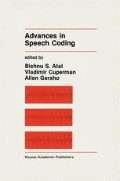Abstract
Pitch prediction [1] plays an important role in many speech coding systems such as multipulse [2] and vector or code-excited linear predictive coders [3]. The pitch predictor removes the redundancy in a periodic speech signal by predicting the current signal from a linear combination of past versions of this signal. The general form of an odd-order pitch predictor with delay M and predictor coefficients b(k) is given by: Equ1 number equation at page 321
Access this chapter
Tax calculation will be finalised at checkout
Purchases are for personal use only
Preview
Unable to display preview. Download preview PDF.
References
B. Atal, “Predictive coding of speech at low bit rates,” IEEE Trans. Communications, vol. COM-30, no. 4, pp. 600–614, April 1982.
B. Atal and J. Remde, “A new model of LPC excitation for producing natural-sounding speech at low bit rates,” Proc. IEEE Int. Conf. Acoust., Speech, Signal Processing, pp. 614–617, 1982.
M. Schroeder and B. Atal, “Code-excited linear prediction (CELP): high quality speech at very low bit rates,” Proc. IEEE Int. Conf. Acoust., Speech, Signal Processing, pp. 937–940, 1985.
N. Jayant and P. Noll, Digital Coding of Waveforms. Englewood Cliffs, NJ: Prentice Hall, 1984.
P. Kroon and B. Atal, “On improving the performance of pitch predictors in speech coding systems,” Proc. IEEE Workshop on Speech Coding for Telecommunications, pp. 49–50, 1989.
P. Kroon and B. Atal, “Pitch predictors with high temporal resolution,” Proc. IEEE Int. Conf. Acoust., Speech, Signal Processing, 1990.
R. Crochiere and L. Rabiner, Multirate Digital Signal Processing. Englewood Cliffs, NJ: Prentice Hall, 1983.
G. Oetken, T. Parks, and H. Schüssler, “New results in the design of digital interpolators,” IEEE Trans. Acoust., Speech, Signal Processing, vol. ASSP-23, no. 3, pp. 301–309, 1975.
T. Parks and D. Kolba, “Interpolation minimizing maximum normalized error for band-limited signals,” IEEE Trans. Acoust., Speech, Signal Processing, vol. ASSP-26, no. 4, pp. 381–384, 1978.
P. Kroon and E. Deprettere, “A class of analysis-by-synthesis predictive coders for high quality speech coding at rates between 4.8 and 16 kb/s,” IEEE J. on Selected Areas in Communications, vol. SAC-6, no. 2, pp. 353–363, February 1988.
Author information
Authors and Affiliations
Editor information
Editors and Affiliations
Rights and permissions
Copyright information
© 1991 Springer Science+Business Media New York
About this chapter
Cite this chapter
Kroon, P., Atal, B.S. (1991). On Improving the Performance of Pitch Predictors in Speech Coding Systems. In: Atal, B.S., Cuperman, V., Gersho, A. (eds) Advances in Speech Coding. The Springer International Series in Engineering and Computer Science, vol 114. Springer, Boston, MA. https://doi.org/10.1007/978-1-4615-3266-8_31
Download citation
DOI: https://doi.org/10.1007/978-1-4615-3266-8_31
Publisher Name: Springer, Boston, MA
Print ISBN: 978-1-4613-6437-5
Online ISBN: 978-1-4615-3266-8
eBook Packages: Springer Book Archive

